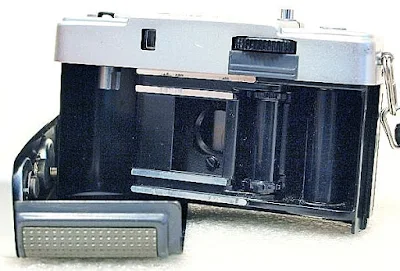The Olympus Pen EE.S is a variant of the Pen E-series cameras, the first fully automatic exposure 35mm half-frame cameras launched for the mass market by Olympus. The Pen E-series was also the smallest camera to use 35mm film in regular 135 cassettes. Images were captured and recorded in 18x24mm half-frame sizes (half the size of a normal 35mm full-frame image), orientated vertically, or in portrait format. The image aspect ratio is 3:4.
Launched in 1962, a year after the initial launch of the first fixed-focus Pen EE (1961) model, which was fitted with a D.Zuiko 28mm F3.5 lens, the Pen EE.S, on the other hand, is fitted with a faster 3-zone focus 4-elements in 3-groups D.Zuiko 30mm F2.8 lens. The camera comes with a set of two shutter speeds, at 1/40 and 1/200 seconds, and accepts film ISO speeds from 10 to 200.
Zone focusing on the EE.S is by rotating the front element of the lens to the appropriate click-stop, which is at 1.2 meters for close-ups, 3 meters for group shots, and 15 meters for scenes. Automatic exposure, as per the rest of the series, is set by aligning the film ISO speed dial to the index mark on the apex of the lens barrel.
Manual exposure, for shooting with flash, is set by rotating the dial to the lens aperture opening scale and aligning the aperture value to the index mark.
HALF FRAME OLYMPUS PEN EES - KODAK COLOR PLUS 200
Point & shot camera HALF FRAME olympus PEN EES with kodak color plus 200 Musik: Dear Autumn Pemusik: @iksonofficial FOLLOW ME Instagram : @muktew https://ins...

The Pen EE.S also incorporates the red flag pop-up underexposure indicator. Activated when underexposure is detected, the shutter will be locked and immobilized, and a red-flag pop-up will be displayed on the lower part of the viewfinder.
Similar to the Pen EE, the Pen EE.S is not fitted with a built-in flash shoe either. Using a flash on the camera is done by mounting the flash on an optional cold-shoe bracket that fits strapped across and over the camera back, secured at the tripod socket.
Basic Camera Features
The Pen EE.S is a very robust and well-built metal and glass construction based on a simple, easy, and economical design concept, with the added convenience of being handy and compact enough to be able to slide into your shirt or pants pocket or carry it in your purse. The camera kit comes with a plastic hand strap and a nice faux leather pouch.
A very simple and plain front, with only the lens and lens housing mount, a flash sync socket on the lower left of the lens mount, and the viewfinder window integrated into the right of the top nameplate decal. The lens itself is surrounded by the selenium cell screen.
Concentric on the base of the mount is the film ISO speed dial, which sets the camera for auto-exposure metering. On the opposite side of the circle are the aperture opening numerals, which are selected if the camera is used with any compatible flash unit.
Zone focusing on the Pen EE.S is done by rotating and setting the front element of the lens to the desired distance click-stop. The front edge of the focusing ring trim is slightly ribbed for better tactile touch, and on the outside perimeter of the trim, the distance icons with the group distance-click stop are done with a red paint graphic icon.
Both the trim ends of the Pen EE.S lens are threaded for screw-in filters. The inner trim accepts 22.5mm filter sizes, which will fit just over the front lens element, and the outer trim will take 43.5mm filter sizes, which will cover the selenium cells as well.
Again a simple and plain top, with the fully recessed film rewind crank on the left end of the top plate, a slightly raised top with the embossed camera model name and the shutter release button on the top-right corner, and the film frame counter display dial with a knurled frame counter arrow on its axis.
The shutter release button is threaded for the shutter release cable, and the film frame counter is set manually with each load of a film roll.
At the back of the top plane is the viewfinder window and the film thumbwheel crank. The film back section is removed completely for loading and unloading the film canister.
The bottom plate, which is integral to the clam-shell back, carries the film back lock, tripod socket, and the rewind release button within a circular recess.
The film box is a normal configuration for a typical 35mm film camera with the film canister chamber to the left, followed by the shutter window, the sprocket gear, and a double slit-in take-up spool.
Film Loading and Unloading
The film is loaded by first taking the film back out completely by a quarter-turn of the film back lock located on the bottom plane of the camera.
Start by inserting the tab end firmly into the slot on the take-up spool, work backward and align the perforations with the sprocket gear, and make sure the film is tensioned properly (with a half-turn of the thumbwheel) before placing the canister in place and resecuring the film. Complete the forward wind and release the shutter button fully.
Repeat the blank shot sequence again, and again (twice) to complete the film loading sequence. Next, set the film ISO speed setting to the film you are using, and finally, use your thumb to set the film frame counter to the number of frames you are in the film roll (72 for a 36-exposure roll, 48 for a 24-exposure roll), and you are all set to go.
Rewinding the film back into its canister is done by first pressing the rewind release button on the bottom plate of the camera and by pulling out and turning the fold-down rewind lever clockwise until the film roll is completely wound back into the film canister. Open the film back again to unload the film canister.
Manual Film Frame Counter
The Pen EE.S is fitted with a manual reset film frame counter with a reverse or descending frame count. The counter is set to the number of frames available on the roll of film used (72 for a 36-exposure roll, 48 for a 24-exposure roll) after the film is loaded. Exposure for the film roll is complete when the counter reaches back to zero (0).
Viewfinder Readout
The viewfinder is a simple, bright frame finder with a luminous image frame line. The only other display within the viewfinder is the red pop-up flag, displayed when underexposure is detected, and the shutter is locked.
Shooting in Auto Mode
The automatic exposure system of the Pen EE is powered by a selenium cell system built around the camera's lens. In bright ambient light, the programmed shutter speed will be set to 1/200 second, and the lens's aperture opening regulated from F22 down to about F11.
In lower light conditions, the shutter speed will switch to the 1/40 second exposure slot, and the lens aperture opening regulated from F11 down to its widest F2.8. This intelligent system keeps the aperture opening from being too small to avoid diffraction.
Shutter Lock Trick
In the situation where the shutter is locked, you still can get away with the shot (though it will be underexposed) by setting the camera to work manually at the slower shutter speed by setting the camera to manual (flash) aperture shooting, without the flash.
You can also use the shutter lock trick, first by pointing the camera to a brighter light source, one which will not trigger the red-flag pop-up, half-pressing the shutter to register the reading, before moving back to the framed scene and releasing the shutter fully.
Lens Equivalent
The 30mm F2.8 lens is equivalent to a 42mm focal length on a 35mm full-frame camera. The crop ratio for lenses manufactured for Olympus half-frame cameras is 1.4.
Depth of Field
With the faster lens and zone focusing capability of the Pen EE.S, images can be captured and composed more creatively with the aid of the following depth of field chart:
Difference Over the Pen EE
The main difference between the Pen EE.S over the original Pen EE is in the wider-aperture lens, the D.Zuiko 30mm F2.8 as compared to the D.Zuiko 28mm F3.5 lens of the Pen EE.
Lenses with a shallow depth of field will show objects losing sharpness as they are further away, or far forward of the main subject, which is zoned within the focusing distances of the lens, which adds to the creative effect of the images.
Model Iteration
The Pen EE.S was upgraded and badged as the Pen EE.S (EL) in 1966, denoted by an EL sticker on the front of the camera. The upgraded version comes with a multi-slot take-up spool to make film loading easier. EL is the acronym for Easy-Load.
Other specifications for the camera remain the same.
Battery
The Pen EE.S does not require a battery to run.
Camera Body Weight
The Olympus Pen EE.S camera's body weight is 400 grams.
Using The Camera
The main advantage of a half-frame camera is the number of shots you can get out of a roll of film, which is double the normal count. Yes, you will get 48 frames out of a 24-frame film roll, and 72 frames from a 36-shot roll. The image frame is, however, oriented in the portrait format, or in the 3:4 image aspect ratio.
The frame size, at 18 x 24mm, is almost the size of an APS-C (22.2 x 14.8mm Canon and 23.5-23.7 x 15.6mm for others) digital camera sensor. When photoprinted, images may be enlarged up to 10R (254x305mm) size. Optionally, auxiliary lenses for the Pen EE are also available. These lenses will enable close-up shots in the 1-meter range.
While the original Pen EE, which is a straightforward point-and-shoot, is definitely the easier one to use and have fun with, getting the best out of the EE.S is by spending a bit more time with its zone focus system and understanding the depth of field application for the correct camera to subject distance in effective and creative image compositions.






























No comments:
Post a Comment